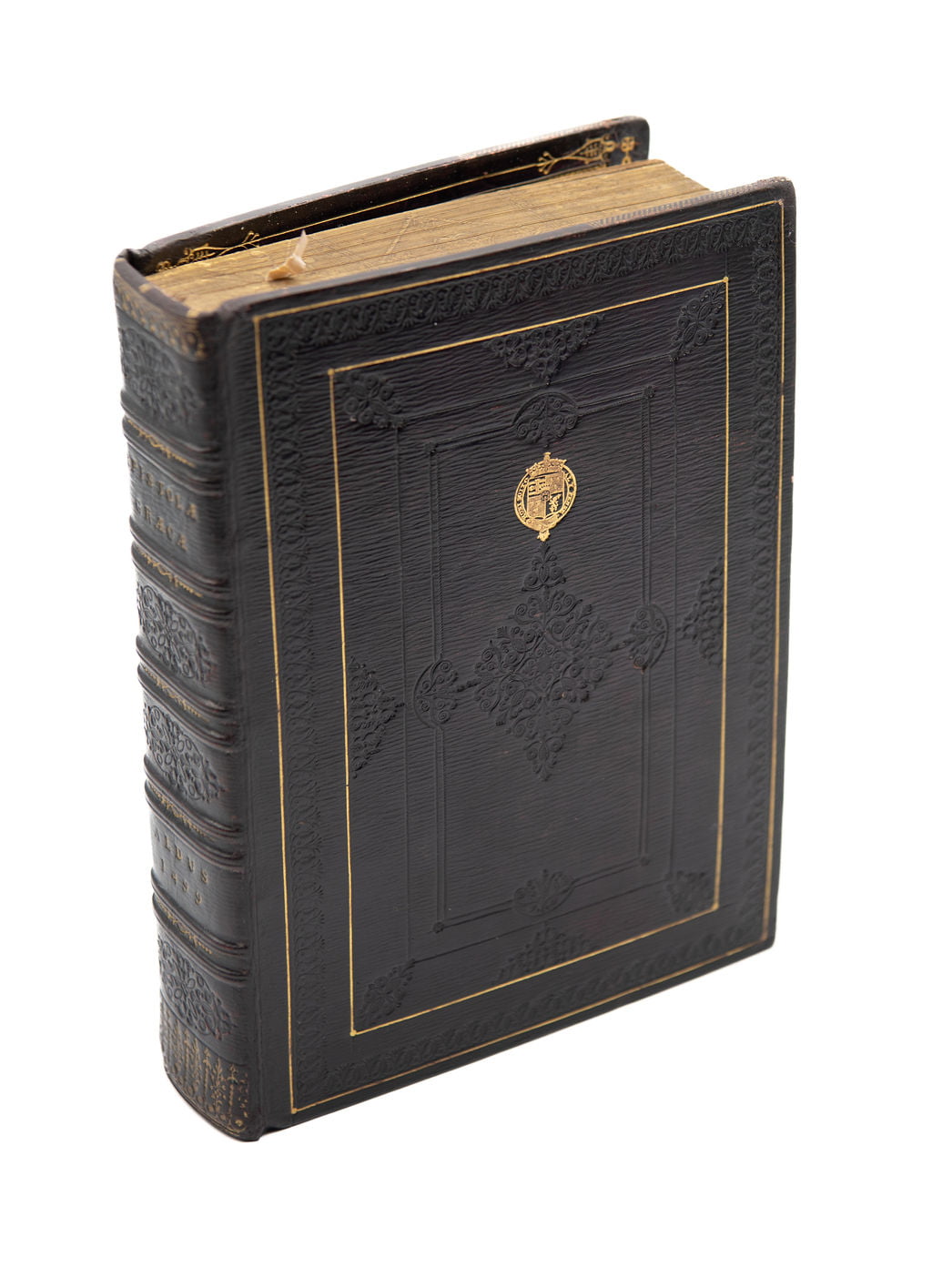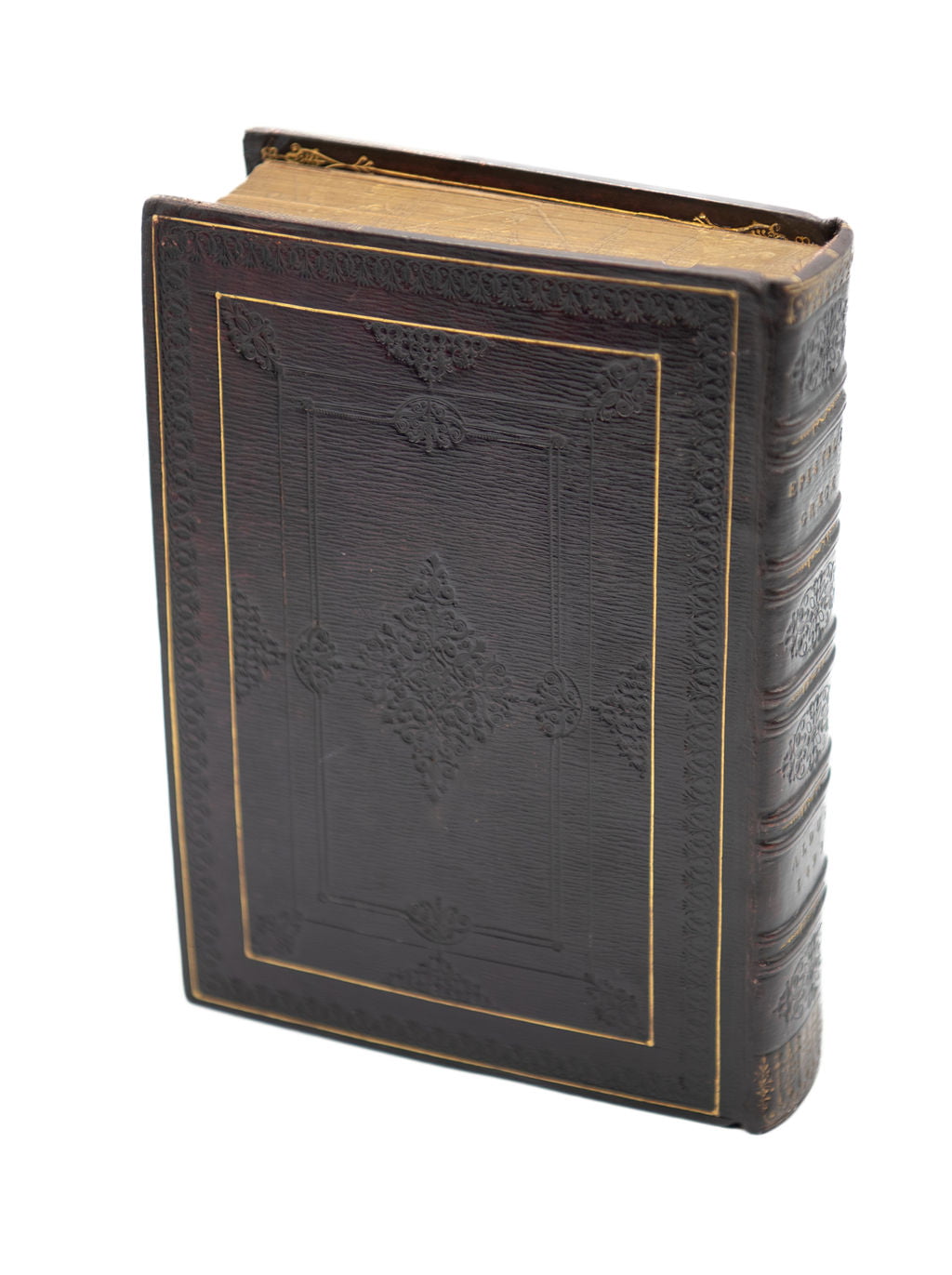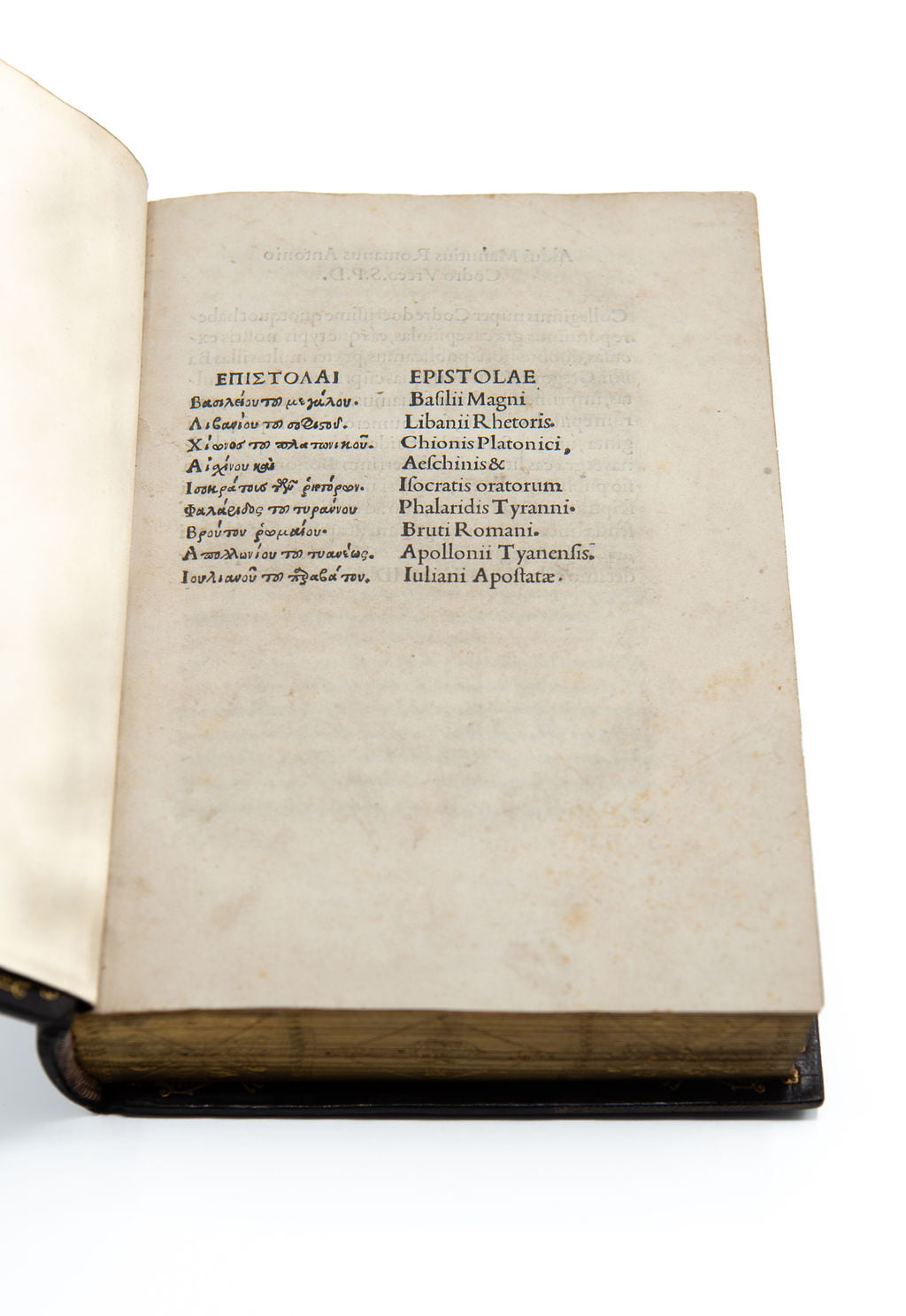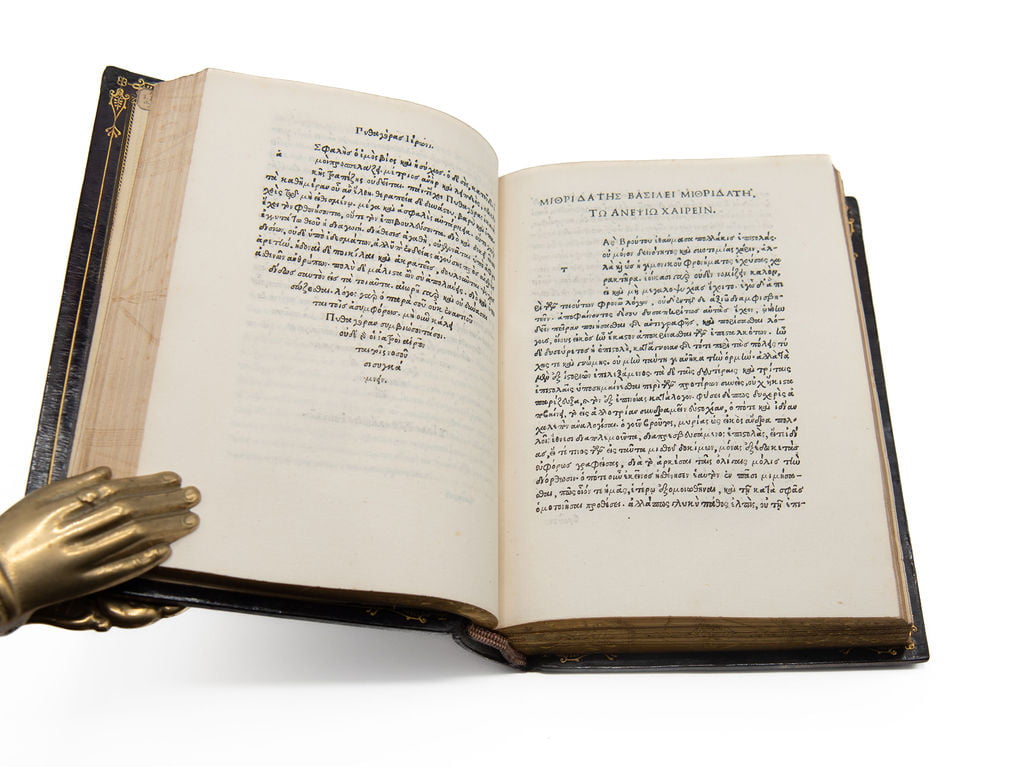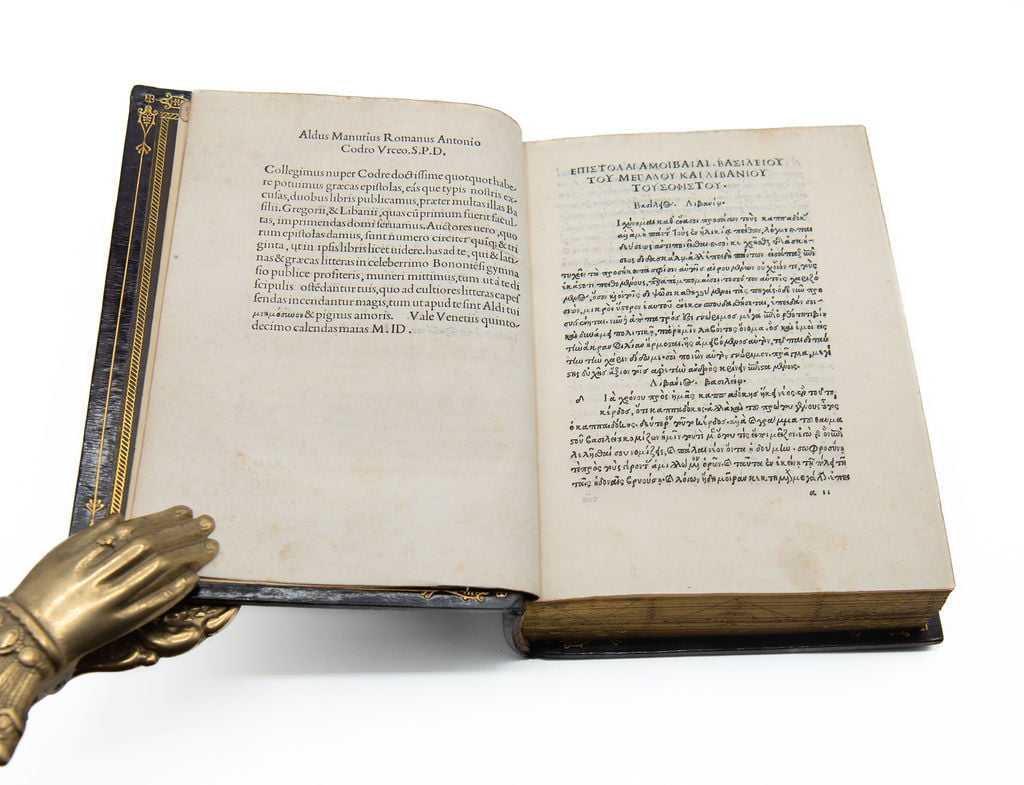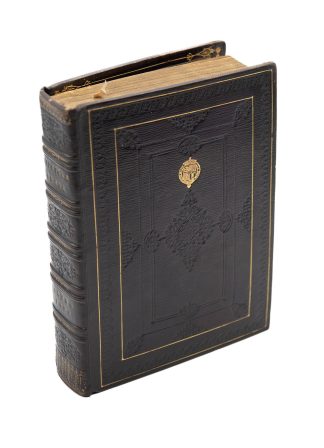EPISTOLAE GRAECAE
Epistolae diversorum philosophorum. .
Venice, Aldus Manutius, 1499, March£35,000.00
EDITIO PRINCEPS. 4to. Two vols in one, part two bound before part one. 1) 138 unnumbered leaves. – 8, – 6, – 8, 6. lacking blank 6 2) 266 unnumbered leaves. 6, – 12, – 8, 10, – 8, 6, – , – 8, 4. lacking blank 8. Greek letter, some Roman. Capital spaces with guide-letters, bookplate of the Bibliotheca Philosophica Hermetica, on front pastedown. Title of vol II fractionally dusty, very occasional very minor thumb mark. Fine copies of both vols, crisp and clean, on thick high quality paper with good clean margins, in sumptuous early C19 ‘Romantic’ straight grained purple morocco by Brooks (his label on fly), bound for George Granville Leveson-Gower, 1st Duke of Sutherland, covers blind and gilt ruled to a panel design, outer panel with blind dentelle border, middle panel with blind fleurons to corners and sides, large blind-tooled finely worked lozenge at centre, the arms of the 1st Duke of Sutherland gilt on upper cover, spine with blind and gilt ruled double raised bands, blind tooled in compartments, gilt tooled at head and tail, inner dentelles and turn ins gilt, brown paper fly and pastedown with gilt borders, all edges gilt and richly gauffered.
A lovely copy of this rare Aldine incunable, the editio princeps of the majority of the letters it contains, including the editio princeps of the letters of Plato and the first printing of any of his writings in the original Greek, edited by Marcus Musursus, perhaps the most influential figure in the progress of the Aldine Greek Press, and beautifully printed by the incomparable Aldus Manutius. Musurus brought together 35 authors in his extensive collection, ranging from Plato, Isocrates and Aeschines from antiquity to 4th-century authors such as Gregory of Nazianzus and later to Procopius of Gaza. Also included are Synesius, Aristotle, Alexander the Great, St. Basil, Phalaridis Tyranni, Bruti Romani, Apollonius of Tyana, and Julian Apostate (Emperor Flavius Claudius Julianus); other letters are spurious or of doubtful authorship, such as those by Hippocrates and Euripides. The book is printed in Aldus’s second and better Greek type (2:114), designed by Francesco Griffo da Bologna. In his dedication to Antonio Urceo Codro (1446-1500) professor of Greek and Latin at Bologna, Aldus states that he has set up in type whatever letters he could procure of some thirty-five Greek writers. A total of twenty six authors were published in these vols. Those that do not appear in this edition he reserved for a later publication, which was never realised. Letter-writing was an art and study allied to rhetoric, which formed part of a humanistic education, and compendia of letters circulated as model precedents. The letters published in this volume however are of interest far beyond mere examples of letter-writing. An example is Plato’s seventh letter, the longest and most important. It is addressed to the associates and companions of Dion, most likely after his assassination in 353 BCE, in the form of an open letter, and contains a defence of Plato’s political activities in Syracuse as well as a long digression concerning the nature of philosophy, the theory of the forms, and the problems inherent to teaching. Toward the end of the letter he gives an explanation of the perfect circle as an existing, unchanging, and eternal form, and explains how any reproduction of a circle is impossible. He suggests that the form of a perfect circle cannot even be discussed, because language and definition are inadequate. This collection was of great influence; Copernicus taught himself Greek using this work with the help of a Greek-Latin dictionary; the manuscript of his De Revolutionibus contains a suppressed passage from Lysis’s letter to Hipparchus found in this collection. Introducing the text of the letter Copernicus mentions “Philolaus believed in the earth’s motion.. (and) Aristarchus of Samos too held the same view”. From 1493, Musurus was associated with Aldus Manutius and belonged to the Neacademia (Aldine Academy of Hellenists), a society founded by Manutius and other learned men for the promotion of Greek studies. Many of the Aldine classics were published under Musurus’ supervision, and he is credited with the first editions of the scholia of Aristophanes (1498), Athenaeus (1514), Hesychius of Alexandria (1514) and Pausanias (1516). Musuros’ handwriting reportedly formed the model of Aldus’ Greek type. Works printed by Aldus Manutius have become synonymous with all that is best with late fifteenth century and early sixteenth-century book production, particularly with typographical elegance and editorial quality and this rare and beautifully produced incunable is no exception. The Aldine Epistolae Graecae ‘was not replaced by an equally useful collection until 1873, the date of R. Hercher’s Epistolographi graeci’ (Wilson, Byzantium to Italy, p.150).
A fine copy with tremendous provenance; Bound for the 1st Duke of Sutherland (1758-1833), described by Charles Greville as a “leviathan of wealth” and “…the richest individual who ever died”. Then in the collection of the great bibliophile Martin Bodmer.


